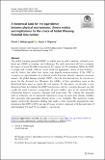A theoretical basis for the equivalence between physical and economic climate metrics and implications for the choice of Global Warming Potential time horizon
Author(s)
Mallapragada, Dharik S; Mignone, Bryan K
Download10584_2019_Article_2486.pdf (1.067Mb)
Publisher with Creative Commons License
Publisher with Creative Commons License
Creative Commons Attribution
Terms of use
Metadata
Show full item recordAbstract
The global warming potential (GWP) is widely used in policy analysis, national greenhouse gas (GHG) accounting, and technology life cycle assessment (LCA) to compare the impact of non-CO2 GHG emissions to the impact of CO2 emissions. While the GWP is simple and versatile, different views about the appropriate choice of time horizon--and the factors that affect that choice--can impede decision-making. If the GWP is viewed as an approximation to a climate metric that more directly measures economic impact--the global damage potential (GDP)--then the time horizon may be viewed as a proxy for the discount rate. However, the validity of this equivalence rests on the theoretical basis used to equate the two metrics. In this paper, we develop a new theoretical basis for relating the GWP time horizon and the economic discount rate that avoids the most restrictive assumptions of prior studies, such as an assumed linear relationship between economic damages and temperature. We validate this approach with an extensive set of numerical experiments using an up-to-date climate emulator that represents state-dependent climate-carbon cycle feedbacks. The numerical results largely confirm the theoretical finding that, under certain reasonable assumptions, time horizons in the GWP of 100 years and 20 years are most consistent with discount rates of approximately 3% and 7% (or greater), respectively.
Date issued
2019-09-09Department
MIT Energy InitiativeJournal
Climatic Change
Publisher
Springer Netherlands
Citation
Mallapragada, Dharik S., and Bryan K. Mignone. "A theoretical basis for the equivalence between physical and economic climate metrics and implications for the choice of Global Warming Potential time horizon." Climatic Change 158, 9 (September 2019): 107-124 doi 10.1007/s10584-019-02486-7 ©2019 Author(s)
Version: Final published version
ISSN
1573-1480
0165-0009